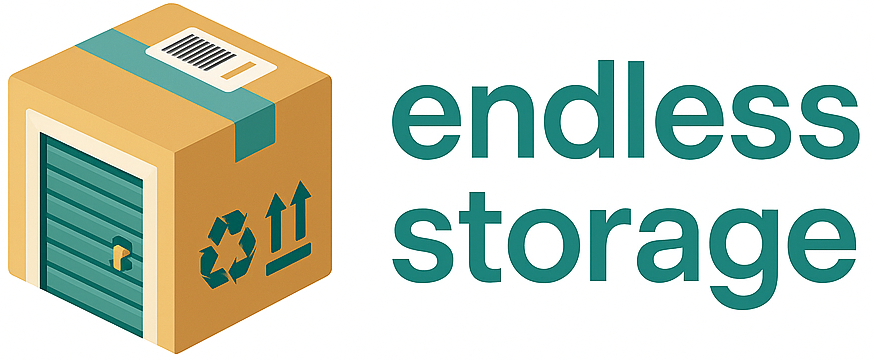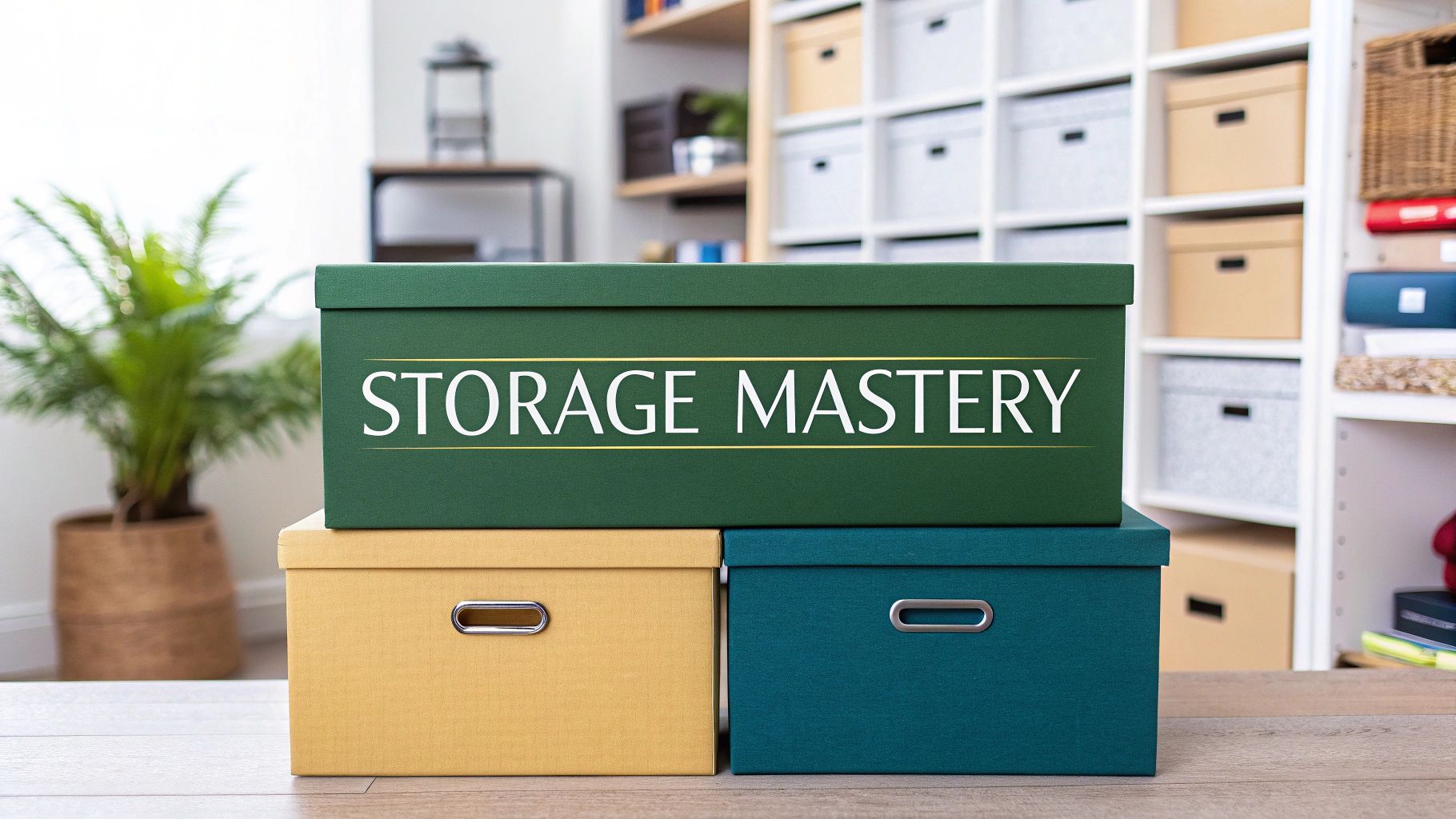When you're staring down a mountain of clutter, it can feel like a losing battle. But the answer is usually simpler than you think: a good storage box with a lid. These aren't just for hiding your messes—they're the fundamental building blocks for getting your life organized, helping you take back your space and keep your favorite things safe.
The Power of Choosing the Right Storage Box
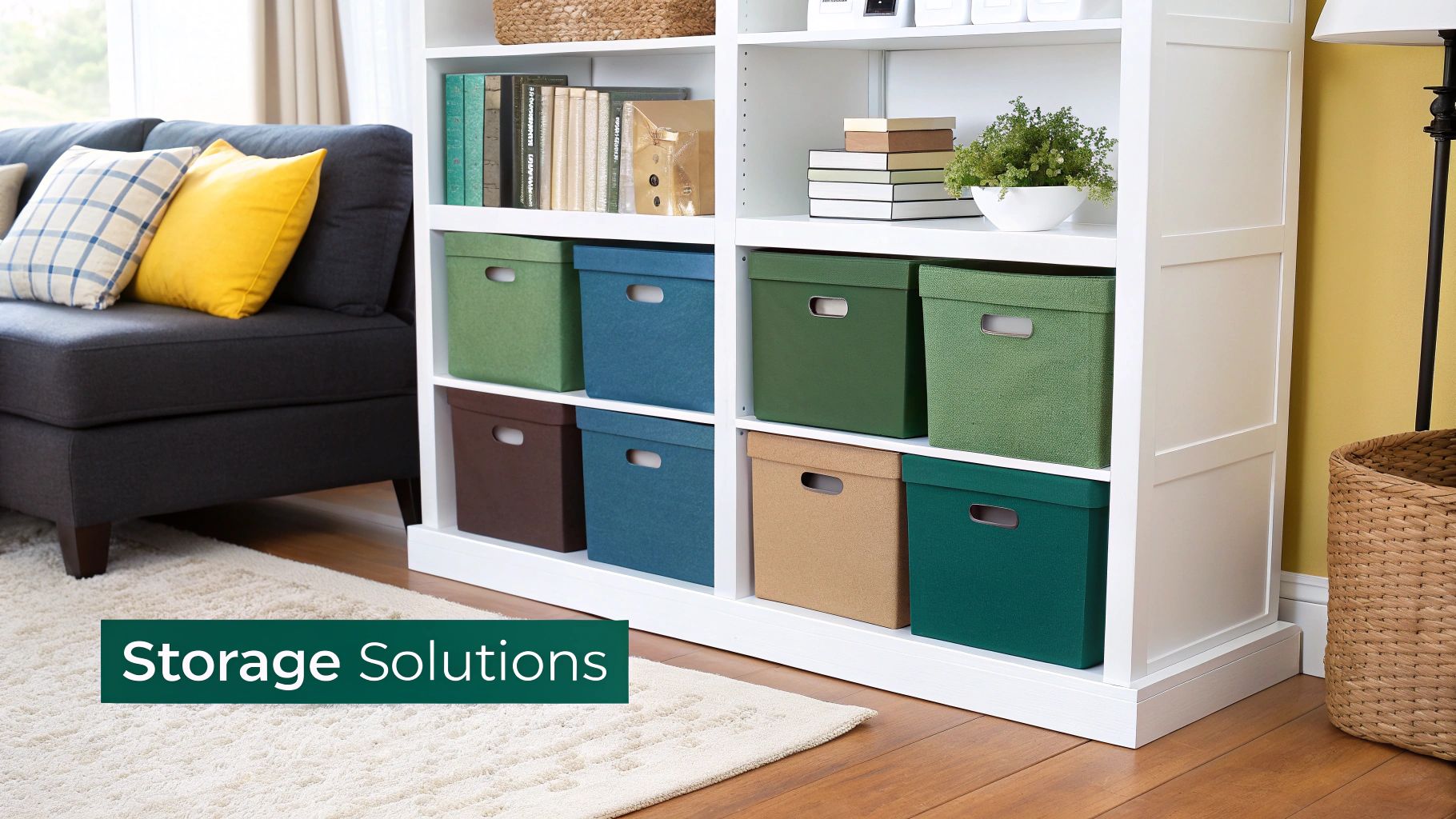
Think of storage boxes as specialized tools for creating order. You wouldn't use a hammer to drive a screw, right? In the same way, you shouldn't grab a flimsy fabric bin for your heavy garage equipment. Picking the right box can turn a chaotic corner into a clean, functional part of your home.
This is more than just a quick purchase; it's an investment in your own efficiency and peace of mind. A well-chosen box protects your valuables from dust, moisture, and pests. A smart system ends that frustrating cycle of tearing the house apart looking for that one thing. Figuring out where to start with packing becomes much clearer once you have the right containers for the job.
Building Your Organizational Foundation
Every journey to a decluttered home starts with a single box. The trick is to turn what feels like a huge chore into a satisfying win, putting you back in control of your environment. An organized space has a real impact on your mental clarity and productivity, which is just one of the many benefits of decluttering.
To make it all work, start by sorting your stuff into categories. This simple first step will tell you exactly what types and sizes of boxes you really need.
- Sentimental Items: Old photos, letters, and family heirlooms need sturdy boxes with tight lids to keep them safe from damage.
- Seasonal Belongings: Think holiday decorations or winter coats. These are perfect for stackable containers that let you use vertical space.
- Frequently Used Items: Hobbies with lots of little pieces—like beads or craft supplies—are much easier to manage in smaller, compartmentalized boxes.
- Heavy-Duty Goods: For things like tools, books, or kitchen appliances, you’ll need robust plastic or wooden boxes that won’t buckle under the weight.
The ultimate goal is to create a system where every single item has a home. This doesn't just clear the physical clutter; it also lifts the mental weight of disorganization. You'll finally be able to find what you need, right when you need it.
This guide will walk you through everything, from figuring out the best materials to mastering the art of stacking. We’ll look at how the perfect lid can safeguard your belongings and how a simple labeling system can finally bring lasting order to your home—one box at a time.
Choosing the Perfect Storage Box Material
Picking the right storage box is a lot like choosing the right tool for a job. You wouldn’t use a paintbrush to hammer a nail, and the material of your storage box dictates what it can protect and where it can live. This isn’t just a minor detail—it’s the most critical factor in keeping your belongings safe and sound.
Think about it: storing heavy power tools in a flimsy fabric box is a recipe for disaster. On the flip side, a bulky wooden crate is overkill for your delicate cashmere sweaters. Each material has its own strengths, and matching it to your storage mission is the key to getting organized. Let’s break down the main contenders.
Plastic: The All-Around Champion
When you picture a storage box with a lid, chances are you’re thinking of plastic. There’s a good reason for that. Plastic is the versatile workhorse of the storage world, perfect for garages, basements, attics, and sheds—all places where moisture and temperature swings are a real concern.
Plastic boxes are incredibly tough and stand up to water, pests, and mold. Their rigid structure means you can stack them high, maximizing vertical space without worrying about crushing what’s inside. This makes them perfect for a huge range of items:
- Holiday Decorations: Keeping delicate ornaments and lights safe from dampness year after year.
- Camping Gear: Protecting tents and sleeping bags from moisture and musty smells.
- Important Documents: When paired with a latching lid, they create a strong seal against environmental damage.
Key Takeaway: For long-term storage in potentially harsh environments, durable and water-resistant plastic is almost always the best choice. It offers the highest level of protection against the most common storage risks.
The demand for these containers is massive. The plastic box market, where storage boxes with lids are a major player, was valued at a staggering $99.9 billion in 2024. Despite small dips here and there, its steady growth shows just how essential these bins are for homes and businesses alike.
The chart below really drives home how effective these boxes are for both organization and protection.
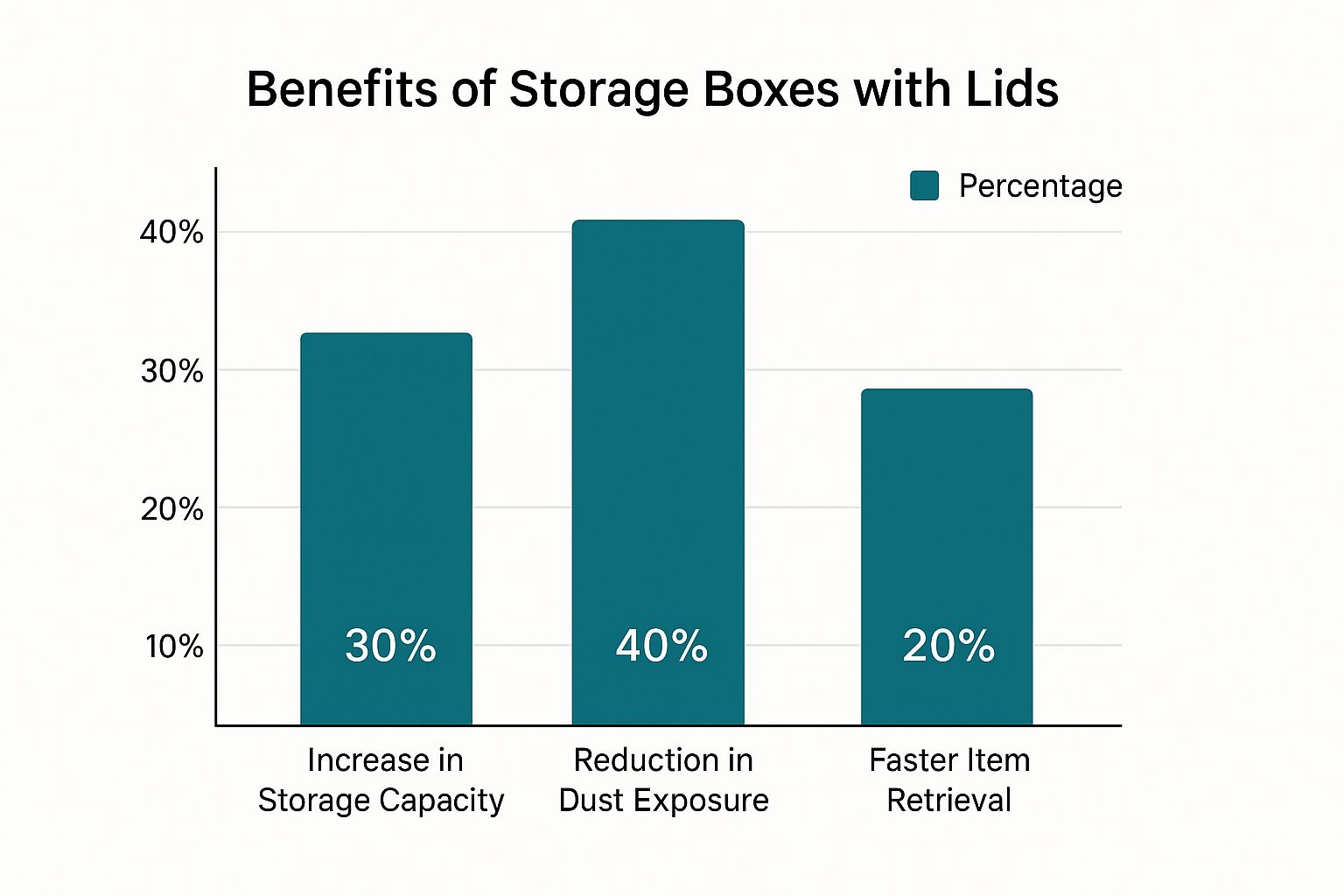
As you can see, the right container doesn't just keep dust off your stuff—it seriously boosts your storage efficiency.
Fabric: A Breathable Solution for Soft Goods
While plastic is all about hardcore protection, fabric boxes bring a gentler, more stylish touch to indoor spaces like closets and bedrooms. Their biggest advantage is breathability. Unlike plastic, fabric lets air circulate, which is a must for preventing musty smells and moisture buildup in natural fibers.
This makes fabric the perfect home for seasonal clothing, linens, and other textiles. Tucking a wool sweater into a sealed plastic bin can trap moisture and cause damage over time, but in a fabric box, it can breathe. If you want to dive deeper into this, check out our guide on how to store clothes long-term.
Fabric storage boxes are also lightweight, often collapsible, and come in countless styles to match your decor. They're ideal for:
- Seasonal Wardrobes: Storing winter coats or summer dresses in a way that keeps them fresh.
- Bed Linens and Towels: Keeping spare sets organized and ready for guests.
- Children's Toys: Providing a soft, safe, and easy-to-access option for a playroom.
Wood: Style Meets Sturdiness
Wooden storage boxes and chests offer a unique blend of durability and good looks. Let’s be honest, they’re more than just containers; they’re often pieces of furniture. A beautiful wooden chest can sit at the foot of your bed, storing extra blankets while doubling as a bench.
Wood is incredibly strong, making it great for heavier items like books, family heirlooms, or even a vinyl record collection. Cedar chests, in particular, are famous for their natural ability to repel moths and other pests, giving top-tier protection for woolens and other delicate fabrics.
The tradeoff? Wood is heavy and not really designed for stacking, making it a better fit for stationary, long-term storage where it becomes part of the room’s decor.
Cardboard: The Economical Mover
Finally, we have the humble cardboard box. It’s definitely not a permanent solution, but cardboard is an affordable, lightweight, and eco-friendly choice for temporary situations, especially moving. It’s easy to find and even easier to recycle when you’re done.
Cardboard’s kryptonite is moisture and pests. A damp basement will turn a sturdy cardboard box into a soggy, useless mess in no time. For that reason, it’s best saved for short-term transport or storage in a completely dry, climate-controlled space. Think of it as the sprinter of the storage world—great for a quick dash, but not built for the marathon.
Storage Box Material Comparison Guide
Feeling overwhelmed? Don't be. Choosing the right material comes down to what you're storing and where it's going to live. This quick-reference guide breaks down the pros and cons of each option to help you make the perfect choice every time.
At the end of the day, a plastic bin will protect your camping gear from a damp garage, while a fabric box will keep your sweaters fresh in the closet. By matching the material to the mission, you’re setting yourself up for organizational success.
Understanding Different Lid Types and Features
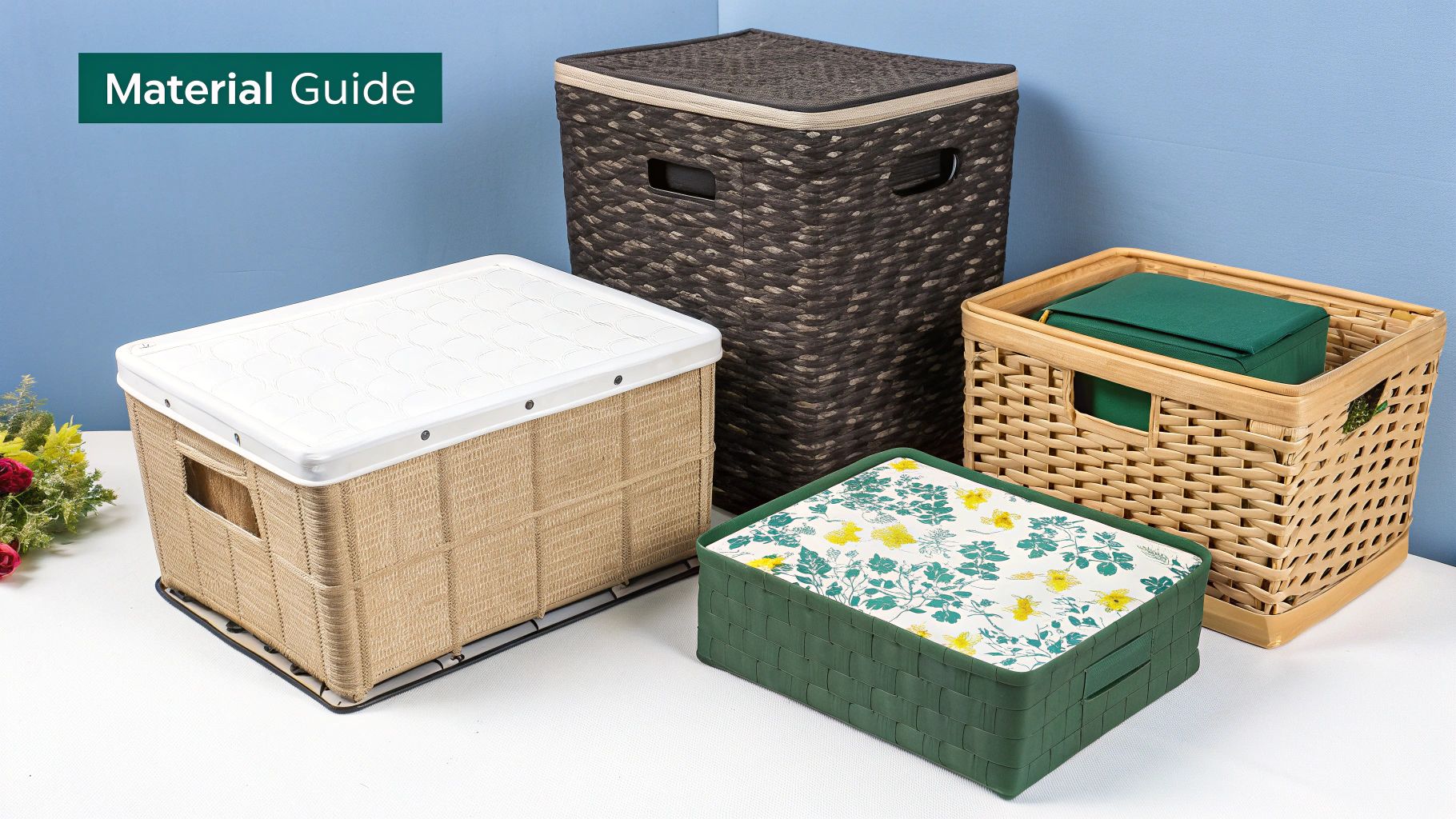
While the box itself holds your stuff, the lid is the unsung hero that guards it. Think of it as the first line of defense against dust, moisture, pests, and the occasional clumsy spill. A box without a lid isn't much more than a bucket, leaving your belongings totally exposed.
Honestly, choosing the right lid is just as critical as picking the right box. The lid style dictates how well your items are protected, how easy they are to get to, and how securely you can stack the boxes. It's like matching the right lock to the right door—sometimes a simple latch will do, but other times you need a deadbolt. Let's break down the common lid types to find the perfect fit for what you're storing.
Snap-On Lids: The Everyday Essential
The most common lid you'll run into is the classic snap-on lid. It’s a simple design where the rim just presses down and “snaps” onto the edge of the box, creating a decent closure. This is your reliable go-to for general storage around the house.
These lids are perfect for things that don't need a perfectly airtight seal but still need solid protection from the basics. They do a great job of keeping dust out and stopping curious pets or pests from getting inside.
- Best for: Clothes, toys, and office supplies you're keeping in closets, bedrooms, or other climate-controlled spots.
- Key Advantage: They’re a breeze to open and close, making them great for items you might need to access every now and then.
The beauty of the snap-on lid is its simplicity. It offers a fantastic balance of protection and convenience for all those everyday organizing tasks.
Latching Lids: For Maximum Protection
When you need to step up your protection game, latching lids are the only way to go. These have sturdy clamps or buckles on the sides that hinge down and lock the lid firmly in place. This mechanism creates a much tighter seal—often weatherproof or even airtight.
Imagine storing irreplaceable family photos in a basement that sometimes gets a little damp. A simple snap-on lid just might not cut it against moisture creeping in over time. But the serious compression you get from a latching lid creates a powerful barrier against the elements.
This kind of secure closure is non-negotiable for long-term storage in places with fluctuating temperatures or humidity, like garages, attics, or sheds. It’s the best way to make sure your most valuable possessions stay pristine.
Latching lids are also a must for securing heavier loads. The strong locking mechanism prevents the lid from popping off if the box gets jostled, making it a much safer choice for moving things around. If you’re using a service that handles your items, like portable storage containers, a tough latching lid ensures everything stays put during transit.
Hinged Lids: The Convenience King
For anything you access frequently, the hinged lid is a total game-changer. Instead of being completely separate, one side of the lid is permanently attached to the box, so it just swings open and shut. The main benefit is simple but huge: you can never lose the lid.
This design is incredibly practical for situations where you're constantly in and out of a container. Think about a child's toy box, a bin for craft supplies, or a container for dog food. The attached lid means you can open it with one hand and never have to wonder where you set the top down.
- Perfect For: Kids' playrooms, craft stations, and pantry organization.
- Main Benefit: Puts an end to the frustration of misplaced lids and makes getting to your stuff way faster.
Special Lid Features You Should Know
Beyond the basic styles, modern storage box lids often have clever features that make them even more useful. Paying attention to these little details can make a massive difference in how well your storage system works.
- Recessed Tops: Look for lids that have indented or grooved tops. This isn't just for looks; it's designed specifically for stable stacking. The base of one box nestles securely into the lid of the one below it, which prevents those wobbly, unsafe towers of boxes.
- Clear Lids: A clear lid on a solid-colored box gives you the best of both worlds. You can quickly see what’s inside without unstacking and opening everything, but the opaque base keeps the space looking neat and tidy.
- Gasket Seals: For the ultimate protection, some latching lids include a foam or rubber gasket along the inner rim. This creates a truly airtight and waterproof seal, making these boxes ideal for archival storage or protecting sensitive electronics from humidity.
How to Master Sizing and Stacking
Ever played a frustrating game of storage Tetris, trying to jam a box into a space it was never meant for? Or worse, created a wobbly tower of mismatched containers that looks like it might collapse at any moment? Sizing and stacking your storage boxes with lids isn't just about being tidy—it’s about safety, efficiency, and getting the most out of every inch of your home.
Think of it as an art form, but one that’s surprisingly easy to get right with a bit of planning. Let’s ditch the guesswork and learn how to build a storage system that’s stable, organized, and secure.
Measure Twice, Buy Once
This is the golden rule for a reason. The most common mistake is buying boxes without knowing the exact dimensions of your storage space. That perfect under-the-bed box is useless if it’s half an inch too tall to actually slide in. Before you even think about shopping, grab a measuring tape.
Measure the height, width, and depth of your key storage zones:
- Under the bed: Don't forget to measure around the bed frame's legs or support beams.
- Closet shelves: Check the vertical space between each shelf and the total depth.
- On top of wardrobes: Make sure there's enough clearance between the wardrobe and the ceiling.
- Garage or basement shelving: Note the precise dimensions of each individual shelf.
Jotting these numbers down is a simple five-minute task that will save you hours of frustration and trips back to the store.
Implement the Storage Zoning Method
Once you know your spatial limits, it's time to match the box to its contents. You wouldn’t store tiny spice jars in a giant stockpot, right? The same logic applies here. This is what I call the storage zoning method, and it's all about matching container volume to the items inside.
The core idea is simple yet powerful: small boxes for small things, large boxes for large things. This prevents tiny items from getting lost in a vast container and stops you from creating boxes that are too heavy to lift safely.
Here’s a practical breakdown:
- Small Boxes (Shoebox Size): These are your best friend for containing small, similar items that tend to create clutter. Think craft supplies, charging cables, or seasonal gear like gloves and scarves.
- Medium Boxes (Banker's Box Size): This is the workhorse size. It’s perfect for things like documents, photo albums, kids' toys, or folded clothes. They hold a good amount without becoming impossible to move.
- Large Boxes (20+ Gallons): Reserve these for bulky but lightweight items. We're talking winter comforters, pillows, and oversized jackets. Packing heavy things like books into a large box is a classic rookie mistake—you end up with something that’s not just immovable but dangerous.
The Golden Rules of Stacking
Stacking is where physics meets organization. A good stack maximizes your vertical space, but a bad one is just a disaster waiting to happen. Follow these fundamental rules to create a storage tower you can trust.
- Heaviest on the Bottom: This is non-negotiable. Placing your heaviest boxes at the base creates a low center of gravity, making the entire stack far more stable and way less likely to topple over.
- Use Uniform Boxes: Whenever you can, stick to boxes from the same brand or product line. They are literally designed to work together, with recessed lids and matching bases that lock into place. This creates a much more secure stack than a random pile of mismatched containers.
- Respect Weight Limits: Check the label. Most manufacturers specify a maximum weight capacity and a recommended stacking height. Pushing these limits can cause the bottom boxes to buckle, warp, or crack, leading to a total collapse of all your hard work.
Pro Organization Hacks for Your Storage Boxes

Alright, you’ve picked out the perfect storage boxes with lids. Now the real fun begins. Having the right containers is a great start, but how you use them is what truly makes a difference. Professional organizers don’t just fill boxes; they use clever hacks to build systems that are tidy, efficient, and surprisingly easy to maintain.
These little tricks transform a simple box into a powerful tool for order. Think of it this way: your box is a blank canvas. These techniques are the brushstrokes that turn a cluttered basement into a masterpiece of organization. It’s all about making your storage work for you, saving you headaches down the road.
Master the Art of Labeling
Let’s be honest, a stack of unlabeled boxes is just a wall of mysteries. You’re forced to play a guessing game, unstacking and opening every single one just to find that one specific thing you need. A solid labeling system is the single most important hack you can adopt, and it goes way beyond a quick scribble with a marker.
There's a reason the home organization market is booming. The global market for storage bins and totes, which includes storage boxes with lids, was valued at a whopping $19.3 billion in 2023 and is projected to climb to $34.5 billion by 2033. People are tired of clutter and are actively looking for smarter ways to live.
Ready to get on board? Try these next-level labeling methods:
- Color-Coded Tape: This is brilliantly simple. Assign a different color of duct tape or electrical tape to each room or category. Blue for bathroom supplies, red for holiday decor, yellow for kitchen overflow. You'll be able to spot the right box from across the room.
- QR Code System: For the tech-savvy, this is a game-changer. Create a quick spreadsheet listing the contents of each box. Use a free online generator to create a QR code, print it out, and stick it on the box. Need to know what's inside? Just scan the code with your phone for a full inventory—no lid-lifting required.
- Detailed Content Lists: Use clear adhesive label pockets on the outside of your boxes. Slip in an index card listing everything inside. When you add or remove something, just pull the card out and update it. No more peeling off old, sticky labels.
For an even deeper dive, check out our complete guide on the best way to label storage bins.
Conquer Clutter Inside the Box
Why stop organizing at the lid? Just tossing a bunch of smaller items into a big container creates a jumbled mess that’s almost as bad as the original clutter. The real pro move is to create structure within the box itself.
Pro Tip: Treat the inside of your storage box like a tiny room. You wouldn't just throw all your furniture into the middle of a room, right? You'd arrange it. Use internal dividers to do the same for your box's contents.
This is especially true for anyone with a hobby. If you want to dive deeper into taming creative chaos, you can learn a lot from guides on organizing craft supplies like a pro.
Here are two internal organization hacks that will change everything:
- Use Internal Dividers: Many boxes come with slots for dividers, but you can easily make your own from sturdy cardboard. They’re perfect for separating things like Christmas ornaments, small tools, or craft beads, stopping them from becoming a tangled disaster.
- Leverage Vacuum-Seal Bags: For bulky textiles like sweaters, blankets, and spare pillows, vacuum-seal bags are pure magic. They compress these items down to a fraction of their original size, often letting you fit three times as much into a single box. As a bonus, they also protect everything from moisture and pests.
By putting these pro-level hacks into practice, your storage goes from being a pile of boxes to a dynamic, easy-to-navigate system. You'll spend less time hunting and more time enjoying your beautifully organized space.
Frequently Asked Questions About Storage Boxes
When you're trying to get your home organized, a few questions always seem to pop up. Getting the right answers about storage boxes with lids can be the difference between a perfectly streamlined space and a pile of new clutter. Here are some no-nonsense answers to the questions we hear the most.
What Is the Best Way to Stack Storage Boxes Safely?
The secret to safe stacking is uniformity. Whenever you can, stick with boxes of the same size and brand; they’re literally designed to lock together. The golden rule? Heaviest boxes always go on the bottom. This creates a solid base with a low center of gravity, preventing any wobbly disasters.
Also, resist the urge to overfill them. A box that’s bulging at the sides is an accident waiting to happen because it creates an unstable surface for the box on top. Always give the manufacturer's stacking height and weight limits a quick look to make sure the bottom boxes won't crack under the pressure.
Are Clear Plastic Storage Boxes Better Than Opaque Ones?
This one really boils down to what you’re storing and where you’re storing it. Neither is better—they just serve different purposes.
Clear boxes are lifesavers when you need to see what’s inside at a glance. No more opening ten boxes just to find the holiday lights. They’re perfect for things like:
- Craft supplies
- Holiday decorations
- Children's toys
Opaque boxes, on the other hand, are your best friend for creating a clean, uniform look that hides visual clutter. They're also essential for protecting light-sensitive items like old photographs, delicate fabrics, or important documents from fading. A lot of people find a hybrid system works best—clear bins in the garage or attic, and sleek opaque ones inside the house.
Key Insight: A great strategy is to use opaque boxes for visual calm in your main living spaces, while leveraging the practical visibility of clear boxes in utility areas like basements or attics.
How Can I Prevent Musty Smells in My Storage Boxes?
That dreaded musty smell almost always comes down to one thing: moisture. The first step is making sure every single item, especially clothes and linens, is completely clean and 100% dry before it goes into the box. Trapped dampness is what causes that stale odor.
For some extra insurance, you can toss in a few moisture-absorbing products like silica gel packets (the kind you find in new shoe boxes) or some activated charcoal sachets.
If you’re packing things away for a while, our guide has some great long term storage tips to keep everything fresh. And if it’s practical, just airing out the contents every so often can make a huge difference.
Ready to reclaim your space without the hassle of a traditional storage unit? Endless Storage delivers durable boxes right to your door. You pack, we pick them up, and your items are stored safely in our secure, climate-controlled facilities. Get your clutter-free home back by visiting https://www.endless-storage.com today.
Frequently Asked Questions
Unveiling the Secrets to Effortless Storage
Endless Storage is available nationwide. You pick a plan, tell us where to pickup, and we'll send a UPS van to collect, whichever state you're in.
Your shipping label will be sent to your email within a few minutes, if not instantaneously. It can also be accessed through your customer profile.
Your box will be shipped to one of our climate controlled self storage facilities in our closest self storage facility. Our manager will accept your package, notify you that your box has been received, and securely stored. Only our managers will have access to Endless Storage boxes.
Email us at admin@endless-storage.com click to live chat with us, or send us a message below.
Never! We're committed to transparent pricing with no surprises. You'll lock in your rate with no hidden fees and no long-term contracts.
Fast access guaranteed! Your boxes will arrive at your doorstep within 48 hours of requesting them back. Need to check on delivery? We provide tracking information for complete peace of mind.
Totally flexible! Store month-to-month with no long-term commitment and cancel anytime.
Everything's online! Use your account dashboard to:
• Set up automatic monthly payments
• Request box returns
• Update your address
• Order additional boxes
• Track shipments
Your boxes are insured up to $100 each. Our customer service team will help you file any necessary claims and resolve issues quickly.
Don't worry – we'll email you right away if there's a payment issue. Your items stay safe, though you may have temporary service interruption or late fees until payment is resolved.
When you request our free storage kits, you'll have 30 days to send in your boxes to activate your 3 months of free storage. Think of it like starting a gym membership – your activation window begins when you receive your kits, and your full free trial begins once you send in your first box. During your free months, you'll experience our complete storage service at no cost.
Your 30-day activation window begins when you receive your storage kits. We'll send you an email confirmation when your kits are delivered, marking the start of your activation period.
If you haven't sent any boxes for storage within your 30-day activation window, your free trial will expire and we'll begin charging the regular monthly rate of $7.99 per box. This helps ensure our storage kits go to customers who are ready to use our service.
A box costs $7.99 per month to store (plus sales tax). This price includes free shipping for standard boxes under 50 lbs. and smaller than 20"x20"x20
Log into your Endless Storage account, locate the box you would like returned, and simply click Return My Box.
Yes, each box stored with us is insured for up to $100 throughout transit as well as the duration of storage within our facilities.
Your box will be at your doorstep within 48 hours of you requesting it back.
Store 10+ boxes? We'll pick them up for free! After your purchase, we'll contact you to schedule a convenient pickup time and arrange UPS collection.
We trust UPS with all shipments, and every box includes $100 insurance coverage. You'll receive tracking information to monitor your items' journey.
Yes! Visit any of our locations by appointment. Just bring a photo ID matching your customer profile.
For everyone's safety, we can't store hazardous materials, firearms, or perishables. All items must fit within our standard boxes.
It's easy! Order your storage kit online, and we'll ship it to you within 1-2 business days. Your shipping labels will be emailed instantly and available in your account.
We're here to help! Email us at admin@endless-storage.com, use our live chat, or send us a message through your account.
To cancel your storage service with Endless Storage, please email your cancellation request to admin@endless-storage.com. Our team will process your request within 2 business days and confirm your cancellation via email.
We understand packing takes time. However, to maintain your free trial benefits, you'll need to send at least one box within the 30-day activation window. If you need more time, you can always start with one box to activate your trial and send the rest later. You can always reach out to admin@endless-storage.com if you have any issues or concerns.
When you request our free storage kits, you're starting a 30-day window to begin using our storage service.
To avoid any charges, simply send at least one box for storage within 30 days to activate your 3-month free trial. If you decide not to use our service and don't send any boxes within the 30-day window, a one-time $50 fee will apply to cover the costs of materials and shipping. This helps ensure our storage kits go to customers who are ready to use our service.
Think of it like reserving a hotel room – we're setting aside space and sending specialized packing materials for your use. The fee only applies if you request materials but don't begin storage, similar to a hotel's no-show charge.
